There are few topics as hotly debated in parenting communities as screen time. Screens are everywhere now. Manufacturers make tablets just for kids. The entertainment industry pumps out tons of content children love to watch. E-gaming is no longer just a way to kill some time, I just saw it as an actual hobby on a high school form.
The world of screen time has changed a lot since we were growing up, and now we’re left to make decisions for our own kids about what makes sense for them developmentally, and what makes sense for our families (and our sanity).
It’s funny to be a parent at this moment in history. We weren’t raised on screens. Our parents told us to go outside and then whistled when it was time for dinner. We know how rewarding exploring the world outside the box can be. On the flip side, we aren’t raising our kids in the 80’s or 90’s. We also know how scary it is to see a kid on a milk carton. Everything outside the four walls of our homes seems scarier than it was in our childhood.
Before delving into screen time recommendations, we want to take a minute to acknowledge that this can be hard. As moms, we understand that sometimes you just need a minute. You need everyone entertained while you quietly regain your sanity. That’s okay.
We’ve put together this list of guidelines to help you, not shame you. Our list of recommendations are age dependent, not factoring in different household settings and home lives. Those vary too widely to factor into recommendations. So just remember, these are guideposts. It’s up to every parent to figure out how to best fit recommendations into particular family circumstances.
Table of Contents
- Pros and Cons of Screen Time
- Infants & Toddlers, 0-2 years old
- Early Childhood, Ages 2-4
- Early School Years, Ages 5-8
- The Eye-Rolling Years, Ages 9-12
- Teen Years, 13 – 18
- Universal Content Suggestions
- Conclusion
Pros and Cons of Screen Time
Before we dive into screen time guidelines by age, it’s important to remember that there are benefits and drawbacks to screens.
Digital life is useful for kids in so many ways. It enables them to connect to people, places, and cultures virtually, and provides them with educational content ranging from financial literacy (My First Nest Egg!) to language-learning courses. Screens can give kids in all socio-economic circumstances the opportunity to develop wide-ranging skills and accumulate useful knowledge. Experts agree that the best course of action is to teach your child to live a healthy life with their devices as opposed to trying to isolate them from it completely.
At the same time, parents must confront the reality that screen time has a lot of negative consequences for young brains. There is the obvious risk of sedentary behavior which can lead to bad habits and impact your child’s physical health. There is also the negative effect that screen time can have on mental health, whether through slowing brain development for young children, impacting sleep patterns, or affecting their mental well-being. And lastly, there is the risk of exposure to inappropriate content and online dangers.
Keeping all of those benefits, drawbacks and risks in mind, we’re here to answer the question: what is an appropriate amount of screentime for children?
Infants & Toddlers, 0-2 years old
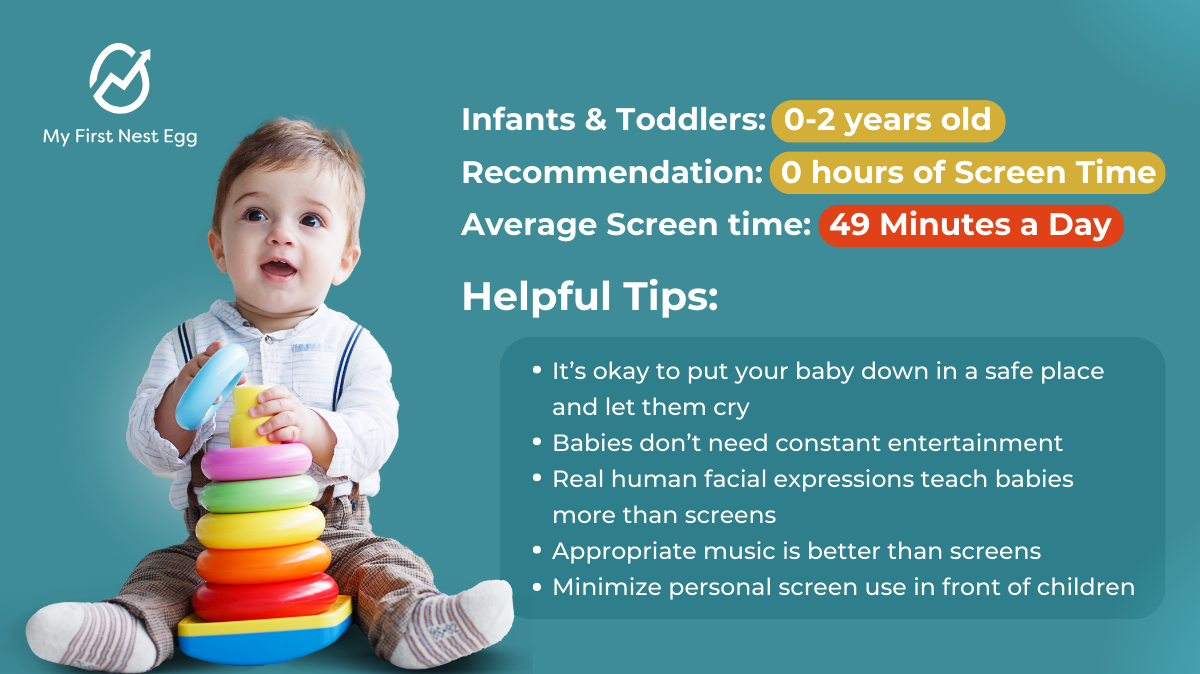
Most experts will say that the screen time recommendation for infants and toddlers is effectively zero. They make exceptions for family video chats and other interactions which now feel like a necessity with long-distance relationships. But other than taking the time to meet grandma and grandpa, screens are not good for infants and toddlers.
The World Health Organization recommends no screen time for this age group because at this age babies need to learn from humans, not machines. They pick up social cues in faces, learn empathy for other humans, and develop methods for interacting with the world. The word to remember is “interaction”. Screens make babies passive, when they need to learn by engaging.
In addition to learning how to interact with the human world around them, babies also need to learn how to be bored. They do not constantly need to be entertained. They need to develop the habits that will allow them to self-soothe and cope when they are not being entertained.
While research into the effects of screen time is fairly young, a 2023 study out of the Journal of the American Medical Association Pediatrics documented an association between greater screen time in 1 year-old children and developmental delays in problem-solving and communication later on, at ages 2 and 4 years.
Beyond science, these are the most important bonding years with your child. They depend on their parents for everything. They think their parents’ faces and voices are the most beautiful, soothing things in the world. They would prefer a nursery rhyme, story book, or a snuggle to any screen. Take the time to enjoy the beauty that comes with this level of baby adoration. You’ll miss it when they’re teens.
Helpful Tips:
- It’s okay to put your baby down in a safe place and let them cry
- Babies don’t need constant entertainment
- Real human facial expressions teach babies more than screens
- Appropriate music is better than screens
- Minimize personal screen use in front of children
Early Childhood, Ages 2-4
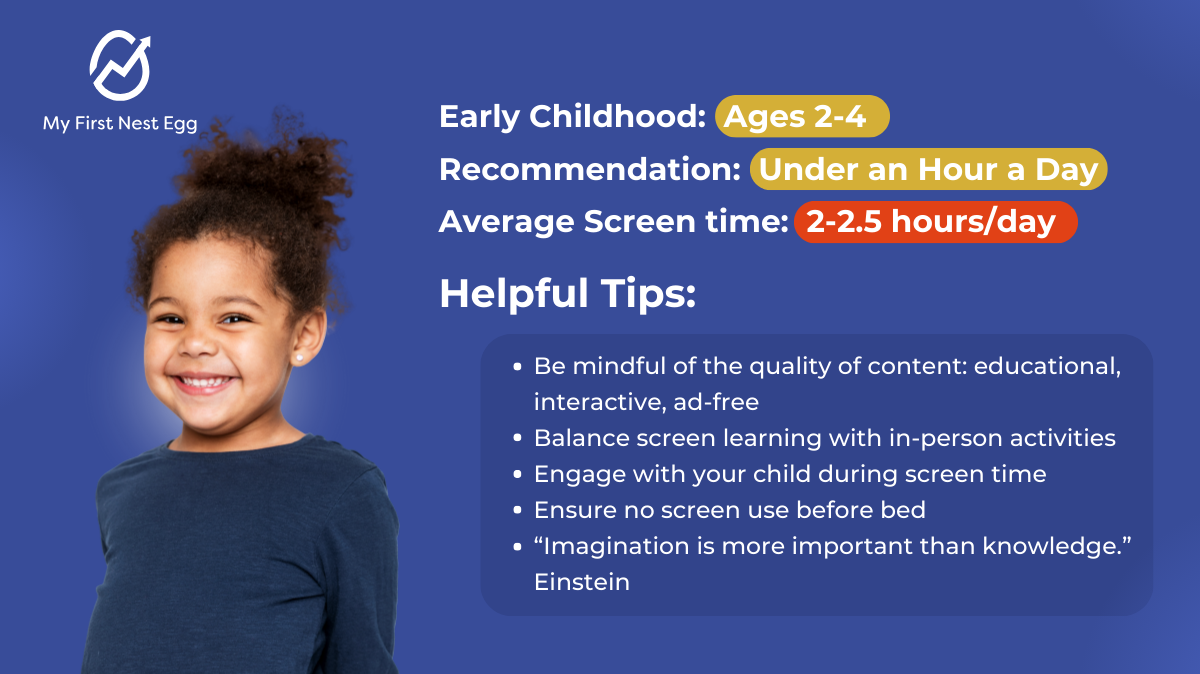
Children under the age of 4 are engaging in rapid development, as their brains are growing and changing every day. Every parent can attest to how much progress kids make in these early years. They go from barely being stable on their feet to running in the blink of an eye. One minute they can’t form complete sentences, and the next they’re singing their ABC’s.
In this stage of life, every little interaction matters. Children are highly dependent on those around them to feed their development. The more time children have engaging with other humans, the better it is for their empathy, emotional intelligence, and overall development.
These little ones learn how to interact with the world around them by watching the adults and children around them. The most important word during these early years is “play.” Little kids learn all of the life lessons through play-based learning.
While it’s easier to keep your kids off screens when they’re little babies, these can start to be harder years to limit screen time. There is a lot of content developed specifically for this age range. This content seems like it’s teaching them good life lessons. How many children’s shows center around the concept of sharing?
But the truth is, watching a show about sharing is not nearly as beneficial as a child learning to share through play. When a child this age takes a toy from another child, that other child might cry. Their face might turn red. They might scream. In that moment, your child will learn more about sharing, empathy, and how to interact with other humans than any screen will ever teach them.
As you start to let your little one use screens, it’s important to remember that all content is not created equally. You can find content for this age range which will provide educational value along with the entertainment. Look for content that will spark their curiosity about the wider world, instead of sucking them further into the screen.
Helpful Tips:
- Be mindful of the quality of content: educational, interactive, ad-free
- Balance screen learning with in-person activities
- Engage with your child during screen time
- Ensure no screen use before bed
- “Imagination is more important than knowledge.” Einstein
Early School Years, Ages 5-8
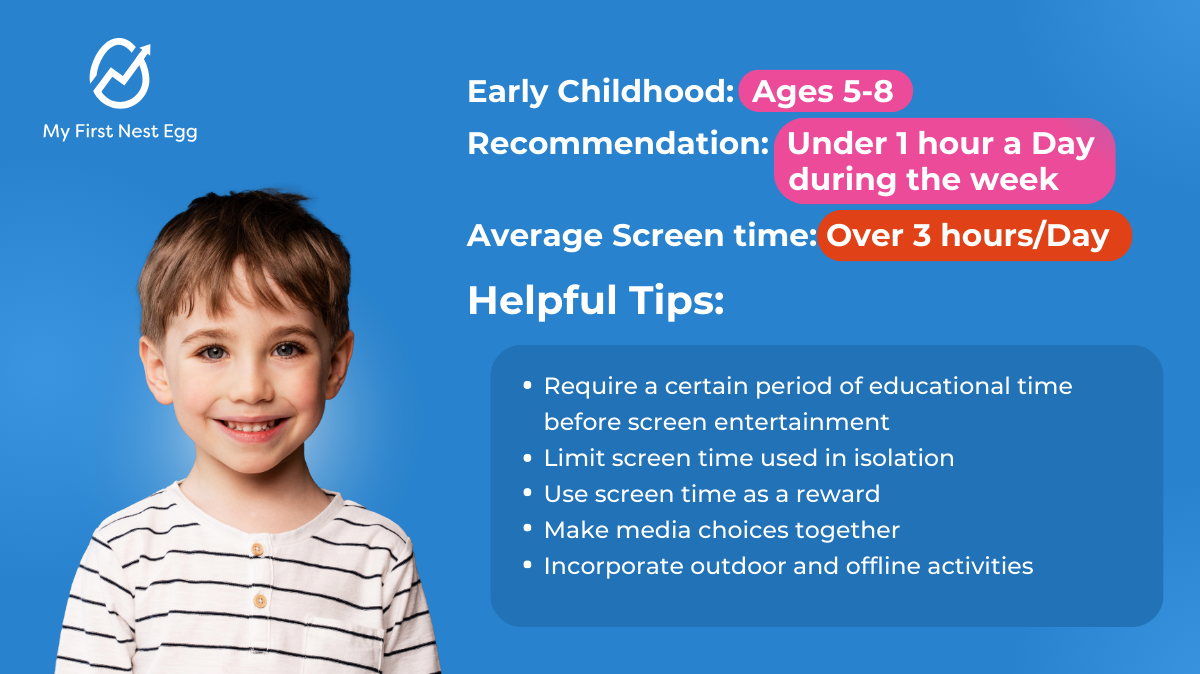
Over the age of 5, official screen time recommendations get murky. Health organizations tend to group all kids together after this time. But if you actually have a child, you know that a 5 year old is very, very different from a 15 year old.
These early school years are important for a child’s school development. Kids learn to read from K-2nd grade. Some are earlier, and some are later. Almost all need some parental involvement in the process. Whether it’s just reading to your child, or helping them sound out words: they need interactive help, not screens.
Beyond simply learning how to read, these are crucial years for kids to develop a love for things outside screens. It doesn’t take a psychologist to tell you that for a 6 year-old, building spaceships and dinosaurs with legos is better than watching someone else build them on TV.
Once a child becomes dependent on a screen for entertainment, it’s very hard to go back. Our generation is one that grew-up being captivated by Nancy Drew and the Babysitter’s Club. We got our drama from Sweet Valley High. Calvin and Hobbs entertained us in the Sunday paper. But once we started replacing our books with the much more fast-paced, entertaining screens, we struggled to go back to the simple words on paper.
Books build and stretch the imagination. They are a way for us to connect with our ancestors and gain knowledge and wisdom passed down from generation to generation.
During these years, if you give a child a choice between a book and a TV show, 99% will take the TV. That’s why it’s so important not to give them that choice.
You can heavily limit screen time to make it a treat, not an expectation. Kids are absolutely capable of playing with toys, dolls, building blocks, or cracking open a comic book for their belly laughs. Guess what? Calvin and Hobbs is just as funny now as it was when we were kids. Suzy is still exasperated, and Calvin is still daydreaming his way through class.
It’s not easy, but less screen time during the week is still possible from 5-8. You only have a few short hours with them between coming home from school or work and bedtime. The higher quality that is, the better it will be for their minds and your family.
If your child is watching screens, start to be very careful about the content. Find shows that lineup with your family values. This will look different for every family, and that’s okay. Get used to the words: “different families, different rules.” Find entertaining content that provides value to your child and family. Common Sense Media is a great resource for checking content before your child starts watching.
Helpful Tips:
- Require a certain period of educational time before screen entertainment
- Limit screen time used in isolation
- Use screen time as a reward
- Make media choices together
- Incorporate outdoor and offline activities
The Eye-Rolling Years, Ages 9-12
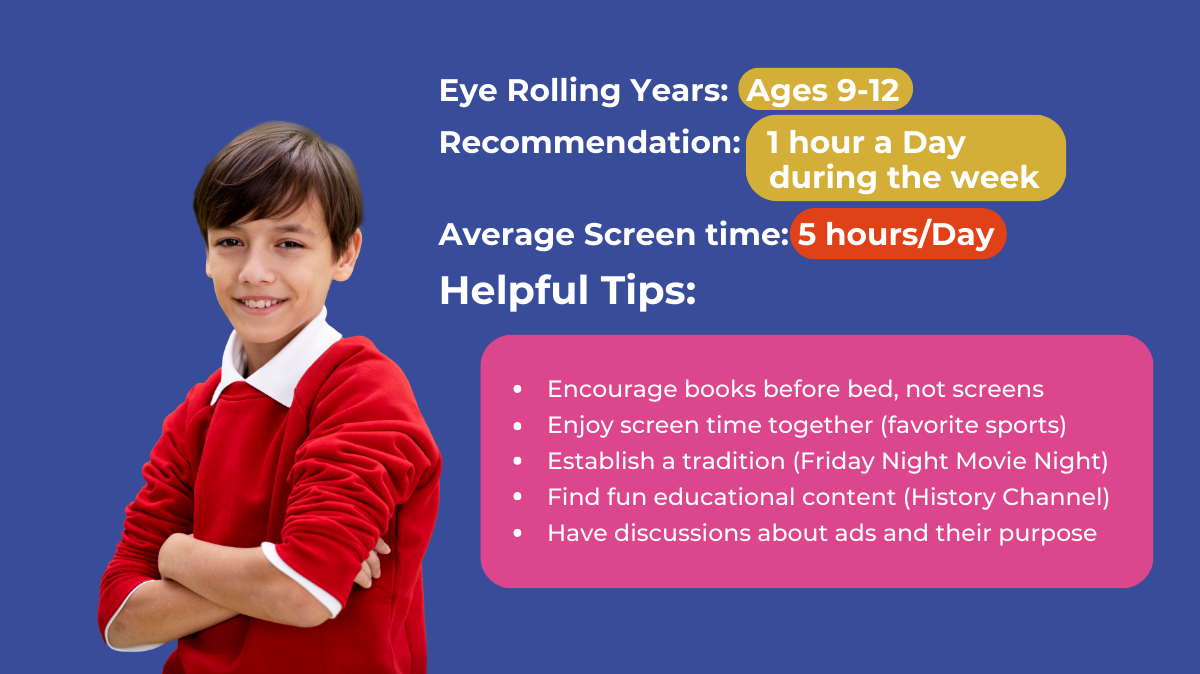
You might be noticing a trend with our recommendations. They’re not really going up. We promise that will change when we start talking about teens, but 9-12 year olds are still just kids.
It’s time to ask yourself, how do you want your child to act? Now, hold that thought in your brain and turn on whatever show your child is begging you for. Instead of binge watching Orange is the New Black, binge watch the latest tween Netflix, Hulu or Disney+ trend.
If those kids are modeling the behavior you want to see in your kids, then you’ll still want to stick with an hour a day because an hour a day is more than enough screen time for anyone.
If those kids are not modeling the behavior you want to see in your kids, then figure out some new activities or have them tune into something else.
Kids in this age range are learning a lot of new information at school. Have you seen the new way to teach math? They don’t just know how to do the equation, they could write a dissertation on why that’s the right way to do the equation. They are expected to read a certain number of books, memorize the location of all 50 states (and for some kids, Europe), and expound on the principles of gravity.
In short, they need the downtime after school to play. At school their heads are filled with information. When they leave, they need to get out their energy, run around outside, use their imaginations, and unload on you about the latest school drama.
One thing you’ll notice about kids this age is that they have a LOT to process. Whether it’s the look from the girl in the back row, a comment from a teacher, or an unfair call from a ref at a basketball game, they need you to hear them.
These kids aren’t teens yet. They don’t think they’re smarter than you. In fact, they still look to their parents for advice and support. If they’re in front of screens, they aren’t getting those quality interactions with their parents. Their advice will come from other sources.
Don’t give away these formative years to social media or questionable teen programming. Do your best to be the person your child will go to when they need affirmation, advice or support. You are the best thing for them, not a screen.
When your kids are on screens at this age keep in mind that there is high quality, engaging content for curious minds. If you have kids who never, ever stop asking why, YouTube can be your friend. If your kids want to know how the Pyramids were built, there’s a show for that. If they cannot get enough of baking, they can learn how in 30 minute increments. Try to find content that will get them more excited and interested in the wide world, not convinced the world can fit into a screen.
Helpful Tips:
- Encourage books before bed, not screens
- Enjoy screen time together (favorite sports)
- Establish a tradition (Friday Night Movie Night)
- Find fun educational content (History Channel)
- Have discussions about ads and their purpose
Teen Years, 13 – 18
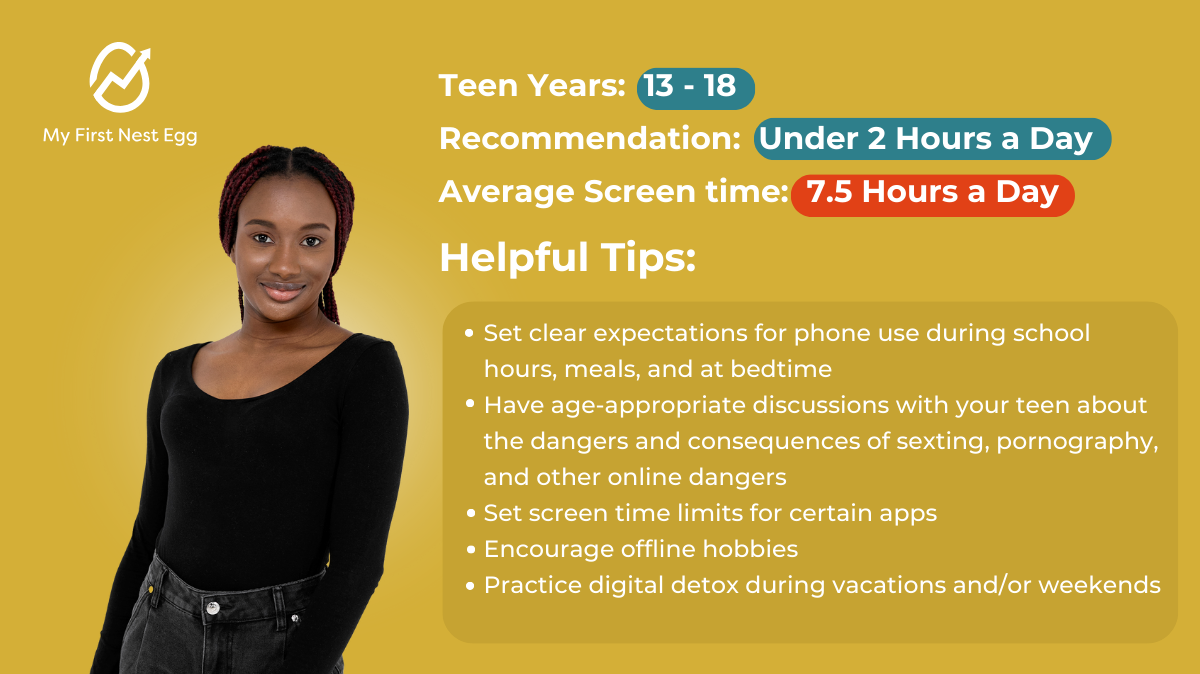
Once children hit their teens, their screen use goes from 4-6 hours a day to up to 9 hours, according to the American Academy of Child and Adolescent Psychiatry.
We are a little confused and concerned by the average amount of screen time for teenagers. How in the world are they fitting a work day’s worth of screen time into their otherwise crowded schedule?
If a teenager has 7.5 hours to spend on a screen, they need something else to do. But chances are the screen is robbing them of one of the things they need most: sleep.
Kids this age (and yes, they’re still kids) need 8-10 hours of sleep. Sadly, 73% of high school students are not getting either the quantity or quality of sleep they need to be productive and healthy during the day.
The culprit? Screens. Studies show that increased access to portable media (phones, tablets and computers) is tied to poorer sleep habits. Teens are curious and screens provide a world of information. Teens are social, and screens provide a world of interaction.Teens are ambitious, and screens give them access to their grades and ways to improve them. But when these things come at the expense of their sleep, their health will suffer.
At this age, screens can pose a real danger. Social media use has been linked to increased depression, loneliness, anxiety, and self-harm – especially in adolescent girls. It is also a place that can expose kids to pornography and sexting. Today, the average age a child is exposed to pornography is 12, and a recent study revealed that over 19% of youth report sending sexts, nearly 35% report receiving them, and 14.5% say they have forwarded sexts without consent.
Since we’re a little on the older side, we asked our college aged intern how she dealt with screens in those formative teenage years. Her answer is one parents need to hear.
Contrary to what they may tell you, teens actually do need and crave structure. When I was about 14, I noticed that I was spending a lot of time online. I had a very curious mind, and easily got sucked into spending hours watching movies, YouTube videos, and browsing the web in the hours that my single mom wasn’t in the house. During this time, I noticed a compulsion – I couldn’t seem to stop myself from going down the internet rabbit-hole once I got started. Somehow, I had the self-awareness to realize this, and I asked my mom point-blank to give me some rules for internet use, because I knew I wouldn’t be able to stop myself. My mom helped me to set boundaries and practices to ensure that I was being accountable for my screen time, and having this restriction helped me immensely.
Remember in these teen years that you’re still in charge. You have the right and responsibility to continue to set boundaries for screen time. It’s harder than turning off Bugs Bunny for your toddler, but equally worthwhile.
Talk to your teen about the upsides and downsides of screens. Discuss how screen time can fit into their lives and schedules. This is a crucial time to teach them how to safely deal with the online world, which is a very scary place for children.
If your kids have access to the internet, there are several tools for you to monitor their usage. This is not spying. You can tell your children you have access to information accessed on parent-provided smart devices and WiFi. This can look like router level protections such as the Gryphon or a service such as Bark.
The key to helping teens practice healthy habits is to guide responsible self-regulation. Talk with your teenager about what you expect from them as far as balancing academic, social, and recreational screen time. What do they feel is a reasonable amount of time to spend on each area? How do they feel after scrolling through social media? What are the positives of having it, and what are the downsides? How do they notice social media affects their peers? What things do they find screen time takes away from? You can both be a guardian and partner.
Helpful Tips:
- Set clear expectations for phone use during school hours, meals, and at bedtime
- Have age-appropriate discussions with your teen about the dangers and consequences of sexting, pornography, and other online dangers
- Set screen time limits for certain apps
- Encourage offline hobbies
- Practice digital detox during vacations and/or weekends
Universal Content Suggestions
The amount of content on screens now seems endless. It is actually one of the problems contributing to the rise in screen time usage among children. We had TVs as kids, but it was pretty limited – even with the broadest cable packages. Sometimes there just wasn’t anything on TV.
The other way to view this endless array of content is as an opportunity. Search for high- quality interactive content. For little children, content that gets them up and moving, singing, dancing, and saying their ABC’s is better than anything that keeps them sitting. As kids get older, content that sparks their curiosity. If after watching a show your child wants to bake, build, travel or experiment, then you’re on the right track.
Screens can also provide valuable opportunities to spend time with your kids. They can help you develop family cultures and traditions. Are you a huge fan of college basketball? March can be an exciting time in your home as everyone builds their brackets and watches their favorite teams. Do you love the NFL playoffs and Superbowl? Watching those can be family activities instead of things that separate you.
Beyond sports, television can be a fun way to connect your children with your childhood. Find movies you loved as a child and watch them with your kids. This will bring back fun memories for you while creating new ones for your children and family. Screens don’t have to take kids away from family interactions; they can be used to enhance them.
Conclusion
Like every part of parenting, the importance of flexibility cannot be overstated. It is crucial to be sensitive to the needs of each individual child, and recognize that your child’s screen time needs (and wants) will change with time. The good news is, that since you are here, you’ve checked-off the most important step: being aware and interested in the digital health of your child.
Parents who focus on providing guidelines for daily screen time limits, model healthy screen use, and adjust limits based on developmental stages, are way ahead of the game.
Most importantly, while certain rules need not be explained, as your child gets older, make sure to involve them in the decisions about screen time and communicate why you’re putting in place the restrictions you do. This not only can serve to make their compliance easier, but also teaches them how to take agency over their own health in a digital society that is constantly competing for their attention.
